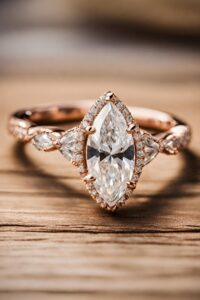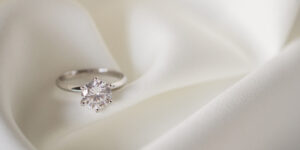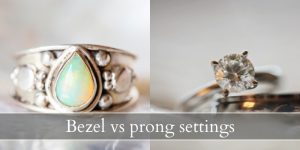When looking for the perfect setting for an engagement ring your head will likely spin. All settings are beautiful and all of them offer something great. But which is right for your ring ? One way to look at this is whether you want the diamond or center stone to be very visible. If yes, two of the main options are cathedral and Tiffany settings.
We’re here to compare cathedral vs Tiffany settings, their pros and cons, and help you figure out which is best for your particular engagement ring.
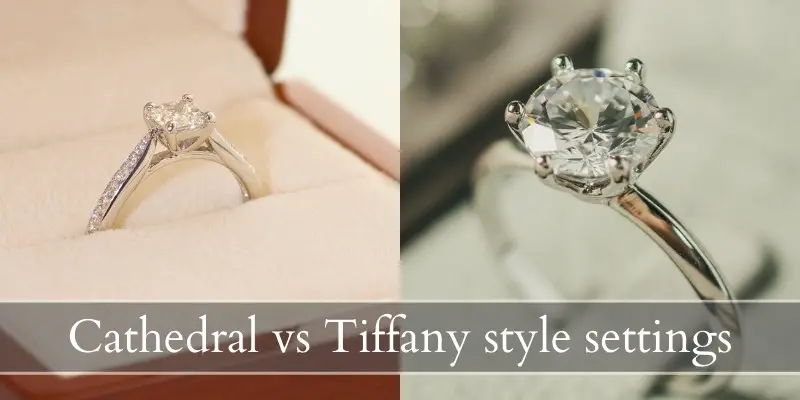
Cathedral vs tiffany setting in rings
Cathedral settings are defined by their shoulders that taper into the band, while Tiffany settings raise the diamond completely above the band. Cathedral settings offer more stability and security for a diamond while Tiffany settings offer more light and thus brilliance in any diamond. Tiffany settings are sleek and minimalistic, most often offer a round brilliant diamond while cathedral settings can hold any sort of diamond cut or shape.
What are Tiffany settings ?
Tiffany settings were first patented by Tiffany & Co. back in 1886. This is a prong setting, defined by 6 strong prongs that are evenly spaced, and they raise the diamond completely above the band. This makes for a high setting, which at the time was innovative and stood opposed to the low-set rings of the time. Buttercup settings, three stone, and halo settings were the norm.
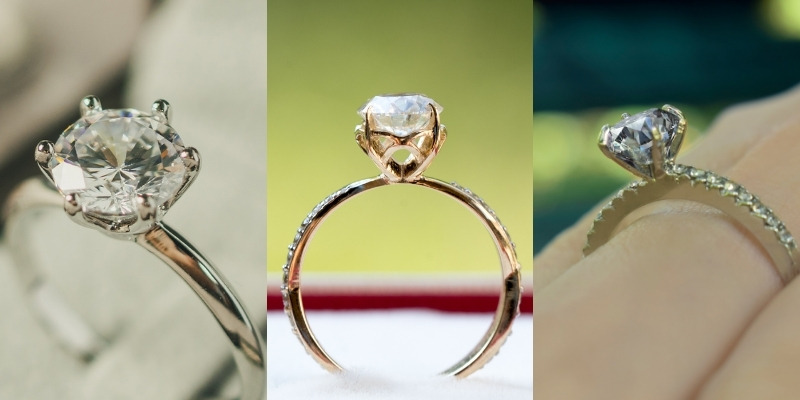
To this day, true Tiffany settings are the ones with 6 prongs, and completely raised above the band, with no other details. However there are so many variations – 4 prongs, 5 prongs, a thin band going around the pavilion – that the Tiffany setting has become more of an idea, than a specific setting type. You may also find these variations under the name of prong setting.
What are cathedral settings ?
Cathedral settings are defined by their shoulders, that is the bands that taper into the shank or ring band. This offers a more streamlined look and is still a high setting. But it does not raise the diamond completely over the band, rather half the diamond is still within the height of the band.
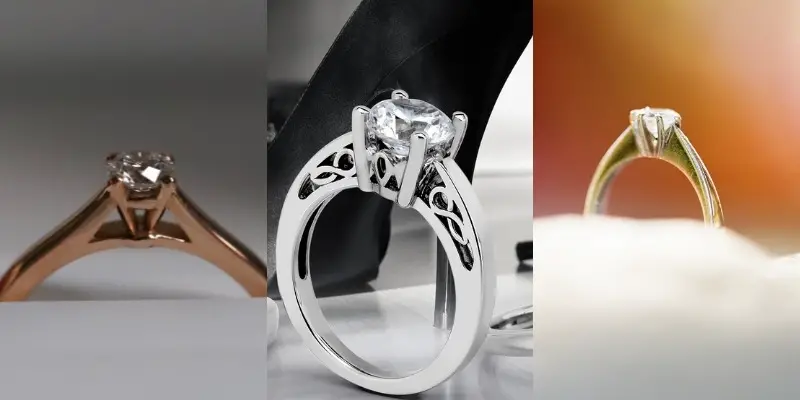
The name of a cathedral setting comes from its resemblance to a cathedral’s tall, vaulted ceilings and impressive details. This leaves room for various detailing and intricate patterns to be applied to the ring. Cathedral rings can easily turn into trellis rings, when there are three stones or more on the ring.
And there are many, many versions of rings that resemble both Tiffany and cathedral settings. This post will focus on the two archetype, not their variations or hybrids.
Now let’s take a closer look at Tiffany settings compared to cathedral settings. Both offer height to the center stone but they do so differently.
1. Cathedral settings are safer, more durable
Cathedral settings are defined by their shoulders, the way they taper into the band and offer more stability to the ring itself. It’s not about how high the stone is set or how many prongs there are, but rather how the stone setting blends into the ring shank itself.
Because of this, cathedral settings manage to be sturdy and distribute weight more evenly than a Tiffany setting. The weight of the diamond is distributed at least across half the ring, due to the angles of the setting. The higher the setting, the more side-heavy the ring will be.
There are sometimes extra bands that go along the diamond’s girdle, or they cross along the height of the diamond.
Read also: Rose Gold VS Yellow Gold
Tiffany settings by contrast raise the diamond extra high, but rely on the 6 prongs to keep the diamond in place. While the prongs rarely ever break, they are still the only thing keeping the diamond onto the band. The connection point between the base of the prongs and the band is small, narrow, and may snap off in the case of larger diamonds, or snag on various objects.
This is why you will never see 6 ct diamonds set in a Tiffany setting. They may be sold by Tiffany & Co. but they have a different setting, more likely a cathedral.
2. Tiffany settings allow more light into the diamond
Due to the way a diamond is raised up and above the band, a Tiffany setting is going to allow much more light into the diamond. This makes for maximum brilliance and sparkle. So no matter what carat weight solitaire you choose, a Tiffany setting will showcase it beautifully.
There is air and empty space right below the culet (tip of the diamond), allowing for light to travel even through its bottom. The girdle is also mostly open, allowing for yet more light. The prongs only extent a little onto the crown, so they don’t block the view of the diamond from above.
The overall effect a Tiffany setting aims for is making the diamond seem like it’s floating above the band. This works especially well with clear (white) diamonds and a white metal like platinum or white gold.
The effect Tiffany & Co. aimed for back in the 1880s is achieved today with the modern floating diamond, otherwise known as resistance setting. The diamond’s girdle is held only by the sheer force of the tension in the ring band. It can never be too large a diamond, but still, it does ‘float’.
A cathedral setting does allow for light to enter a diamond too, but not as much as a Tiffany setting. The shoulders and extra 1 or two bands block some of the light. The diamond does still shine, don’t get us wrong, and it shines very brightly indeed. But it’s less, compared to a Tiffany setting.
3. Cathedral settings look more intricate and detailed
As there are more metal bands tapering onto the ring shank, the cathedral setting tends to look more intricate and detailed just by this alone. Of course there are cathedral settings with various kinds of beading down the side, knife-edge shank, pave diamonds down the side, a halo around the center stone, and so much more.
There are plenty of options to choose from if you want a more intricate-looking ring, and most of them feature a cathedral setting. Remember, a cathedral setting can have a bezel instead of prong holding the diamond in place. It’s about how the diamond is raised above the band, rather than it being a prong setting.
Tiffany settings are more sleek, simplistic by comparison. They are most often a simple band, sometimes knife-edge (raised along the middle), and rarely have any diamonds going down the sides. If they do, it’s either a few set in a pave or channer style. But the most common are the simpler ones.
In case you have a more intricate wedding band, or just want your ring (engagement or not) to be very simple and showcase just the diamond itself, then Tiffany setting is what you should be looking for. If you want something more complex, then a cathedral setting is a better option.
4. Tiffany setting is the classic, round brilliant solitaire
The Tiffany setting is that classic engagement rings most of us see in movies and probably the ones our mothers and grandmothers wore. It was the ring to have. It was meant to showcase a round brilliant’s wonderful cut and its, well, brilliance. Once this setting hit the displays it became very popular and the reference for many engagements to come.
However due to the way the prongs are set onto the band, this setting doesn’t really allow much flexibility in terms of carat and shape.
The carats can’t be very large on the solitaire, so anything over 2 carats are a bit risky to wear. The heavier the diamond, the easier it is for the ring to always slip to one side or the other as it’s worn.
As for the shape of the diamond, anything that isn’t round, or square will have a hard time keeping its center. So diamonds that are round, short ovals, cushion cuts, princess cuts, and square cuts are all just fine to set in a Tiffany setting. Anything more extravagant will have to be set in a cathedral style.
This is because a cathedral style may feature another horizontal band going around the diamond’s pavilion, or thin bands that criss cross along the pavilion. This means extra security for the diamond, and something like a 3 carat marquise would sit tight onto the ring. Or even a heart shape, or something like an emerald cut or radiant cut would also work just fine.
So in short both cathedral and Tiffany settings are beautiful, tall settings for a diamond. Both will make your diamond shine, but Tiffany will make it shine even brighter. You’re restricted to only a few diamond shapes and sizes, but for most people an engagement ring is a big spend anyway.
If you’re wondering which has more bling, you can find both setting styles with extra diamonds on the shank.

I’m the main author for jewelrymaterialguide.com. I started this site after we did tons of research before our wedding and noticed that there is information about rings, jewelry, and so on that is really hard to find on the internet.

